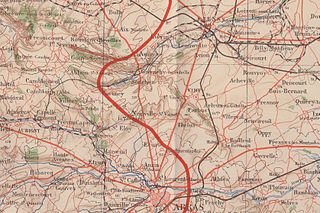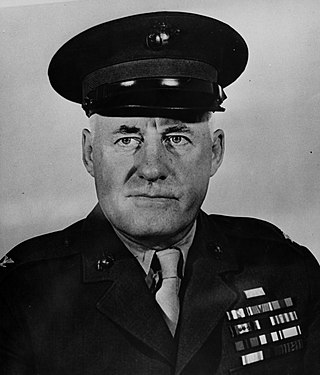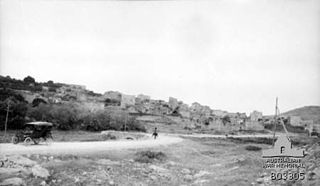
The Battle of Verdun was fought from 21 February to 18 December 1916 on the Western Front in France. The battle was the longest of the First World War and took place on the hills north of Verdun-sur-Meuse. The German 5th Army attacked the defences of the Fortified Region of Verdun and those of the French Second Army on the right (east) bank of the Meuse. Using the experience of the Second Battle of Champagne in 1915, the Germans planned to capture the Meuse Heights, an excellent defensive position, with good observation for artillery-fire on Verdun. The Germans hoped that the French would commit their strategic reserve to recapture the position and suffer catastrophic losses at little cost to the German infantry.

The Battle of Vimy Ridge was part of the Battle of Arras, in the Pas-de-Calais department of France, during the First World War. The main combatants were the four divisions of the Canadian Corps in the First Army, against three divisions of the German 6th Army. The battle took place from 9 to 12 April 1917 at the beginning of the Battle of Arras, the first attack of the Nivelle Offensive, which was intended to attract German reserves from the French, before the French attempt at a decisive offensive on the Aisne and the Chemin des Dames ridge further south, several days later.

The Second Battle of the Marne was the last major German offensive on the Western Front during the First World War. The attack failed when an Allied counterattack, supported by several hundred tanks, overwhelmed the Germans on their right flank, inflicting severe casualties. The German defeat marked the start of the relentless Allied advance which culminated in the Armistice with Germany about 100 days later.

The Battle of Arras was a British offensive on the Western Front during the First World War. From 9 April to 16 May 1917, British troops attacked German defences near the French city of Arras on the Western Front. The British achieved the longest advance since trench warfare had begun, surpassing the record set by the French Sixth Army on 1 July 1916. The British advance slowed in the next few days and the German defence recovered. The battle became a costly stalemate for both sides and by the end of the battle, the British Third Army and the First Army had suffered about 160,000 casualties and the German 6th Army about 125,000.

The first day on the Somme, 1 July 1916, was the beginning of the Battle of Albert (1–13 July), the name given by the British to the first two weeks of the 141 days of the Battle of the Somme in the First World War. Nine corps of the French Sixth Army and the British Fourth and Third armies attacked the German 2nd Army from Foucaucourt south of the Somme, northwards across the Somme and the Ancre to Serre and at Gommecourt, 2 mi (3.2 km) beyond, in the Third Army area. The objective of the attack was to capture the German first and second defensive positions from Serre south to the Albert–Bapaume road and the first position from the road south to Foucaucourt.

The Battle of the Ancre Heights, is the name given to the continuation of British attacks after the Battle of Thiepval Ridge from 26 to 28 September during the Battle of the Somme. The battle was conducted by the Reserve Army from Courcelette near the Albert–Bapaume road, west to Thiepval on Bazentin Ridge. British possession of the heights would deprive the German 1st Army of observation towards Albert to the south-west and give the British observation north over the Ancre valley to the German positions around Beaumont-Hamel, Serre and Beaucourt. The Reserve Army conducted large attacks on 1, 8, 21, 25 October and from 10 to 11 November.

The Second Battle of Artois from 9 May to 18 June 1915, took place on the Western Front during the First World War. A German-held salient from Reims to Amiens had been formed in 1914 which menaced communications between Paris and the unoccupied parts of northern France. A reciprocal French advance eastwards in Artois could cut the rail lines supplying the German armies between Arras and Reims. French operations in Artois, Champagne and Alsace from November–December 1914, led General Joseph Joffre, Generalissimo and head of Grand Quartier Général (GQG), to continue the offensive in Champagne against the German southern rail supply route and to plan an offensive in Artois against the lines from Germany supplying the German armies in the north.

The Battle of Hill 70 took place in the First World War between the Canadian Corps and five divisions of the German 6th Army. The battle took place along the Western Front on the outskirts of Lens in the Nord-Pas-de-Calais region of France between 15 and 25 August 1917.

The first United States occupation of the Dominican Republic lasted from 1916 to 1924. It was one of the many interventions in Latin America undertaken by the military forces of the United States in the 20th century. On May 13, 1916, Rear Admiral William B. Caperton forced the Dominican Republic's Secretary of War Desiderio Arias, who had seized power from President Juan Isidro Jimenes Pereyra, to leave Santo Domingo by threatening the city with naval bombardment. The Marines landed three days later and established effective control of the country within two months. The U.S. occupations of Haiti and the Dominican Republic led to clashes that killed 290 U.S. Marines, over 3,000 Haitians, and hundreds of Dominicans. Despite having much greater firepower, it took the U.S. Marines five years to suppress an insurgency in the eastern provinces of El Seibo and San Pedro de Macorís.

Roswell Winans was a highly decorated United States Marine, who as a First Sergeant earned the Medal of Honor during combat in the Dominican Republic. He was later commissioned and served as a company officer with the 5th Marine Regiment in France receiving several citations for bravery in combat.

The British Army during the First World War fought the largest and most costly war in its long history. Unlike the French and German Armies, the British Army was made up exclusively of volunteers—as opposed to conscripts—at the beginning of the conflict. Furthermore, the British Army was considerably smaller than its French and German counterparts.

The Capture of Regina Trench was a tactical incident in 1916 during the Battle of the Somme during the First World War. Regina Trench was the Canadian name for a German trench dug along the north-facing slope of a ridge running from north-west of the village of Le Sars, south-westwards to Stuff Redoubt, close to the German fortifications at Thiepval. It was the longest such German trench on the Western Front. Attacked several times by the Canadian Corps during the Battle of the Ancre Heights, the 5th Canadian Brigade of the 2nd Canadian Division briefly controlled a section of the trench on 1 October but was repulsed by counter-attacks of the German Marine Brigade, which had been brought from the Belgian coast. On 8 October, attacks by the 1st Canadian Division and the 3rd Canadian Division on Regina Trench also failed.

The Battle of Tabsor was fought on 19–20 September 1918 beginning the Battle of Sharon, which along with the Battle of Nablus formed the set piece Battle of Megiddo fought between 19 and 25 September in the last months of the Sinai and Palestine Campaign of the First World War. During the infantry phase of the Battle of Sharon the British Empire 60th Division, XXI Corps attacked and captured the section of the front line nearest the Mediterranean coast under cover of an intense artillery barrage including a creeping barrage and naval gunfire. This Egyptian Expeditionary Force (EEF) victory over the entrenched Ottoman Eighth Army, composed of German and Ottoman soldiers, began the Final Offensive, ultimately resulting in the destruction of the equivalent of one Ottoman army, the retreat of what remained of two others, and the capture of many thousands of prisoners and many miles of territory from the Judean Hills to the border of modern-day Turkey. After the end of the battle of Megiddo, the Desert Mounted Corps pursued the retreating soldiers to Damascus, six days later. By the time the Armistice of Mudros was signed between the Allies and the Ottoman Empire five weeks later, Aleppo had been captured.

Operations on the Ancre took place from 11 January – 13 March 1917, between the British Fifth Army and the German 1st Army, on the Somme front during the First World War. After the Battle of the Ancre, British attacks on the Somme front stopped for the winter. Until early January 1917, both sides were reduced to surviving the rain, snow, fog, mud fields, waterlogged trenches and shell-holes. British preparations for the Battle of Arras, due in the spring of 1917, continued.

The Capture of Lesbœufs [25 September 1916] was a tactical incident in the Battle of the Somme. Lesbœufs was a village on the D 74 between Gueudecourt and Morval, about 30 miles (48 km) north-east of Amiens; Le Transloy lies to the north-west and Bapaume is to the north. French Territorials fought the II Bavarian Corps on the north bank of the Somme in late September 1914, after which the front line moved west past the village. Little military activity occurred round the village until the beginning of the Battle of the Somme, when German troops passed through the village in the first weeks of the battle. During the Battle of Flers–Courcelette (15–22 September), advances by the right flank corps of the British Fourth Army, brought the front line forward to the Gallwitz Riegel trenches west of Lesbœufs but exhaustion prevented the British from reaching their third objective, a line east of Morval, Lesbœufs and Gueudecourt.

The Capture of Montauban, took place on 1 July 1916, the first day of the Battle of the Somme, between the British Fourth Army and the French Sixth Army against the German 2nd Army, on the Western Front, during the First World War. Montauban is a commune in the Somme départment in Picardy in northern France and lies on the D 64, between Guillemont to the east and Mametz to the west. To the north are Bazentin-le-Petit and Bazentin-le-Grand. Bernafay and Trônes woods are to the north-east and Maricourt lies to the south.

The battle for Outpost Vegas was a battle during the Korean War between the armed forces of the United Nations Command (UN) and China from 26 to 30 March 1953, four months before the end of the Korean War. Vegas was one of three outposts called the Nevada Cities north of the Main Line of Resistance (MLR), the United Nations defensive line which stretched roughly around the latitude 38th Parallel. Vegas, and the outposts it supported, Reno and Carson, were manned by elements of the 1st Marine Division. On 26 March 1953 the Chinese People's Volunteer Army (PVA) launched an attack on the Nevada Cities, including Vegas, in an attempt to better the position of China and North Korea in the Panmunjon peace talks which were occurring at the time, and to gain more territory for North Korea when its borders would be solidified. The battle raged for five days until PVA forces halted their advance after capturing one outpost north of the MLR on 30 March, but were repelled from Vegas. The battle for Outpost Vegas and the surrounding outposts are considered the bloodiest fighting to date in western Korea during the Korean War. It is estimated that there were over 1,000 American casualties and twice that number of Chinese during the Battle for Outpost Vegas. The battle is also known for the involvement of Sergeant Reckless, a horse in a USMC recoilless rifle platoon who transported ammunition and the wounded during the U.S. defense of outpost Vegas.
The Battle of Guayacanas was fought on 3 July 1916 between Dominican rebels and the United States during the United States occupation of the Dominican Republic. The Dominicans dug trenches on two hills blocking passage to Santiago and kept up single-shot fire against the automatic weapons of the Americans before the Americans drove them off. Joseph A. Glowin, a corporal, was awarded the Medal of Honor for his bravery during the action.

The Capture of Ovillers was a British local operation during the Battle of Albert, the name given by the British to the first two weeks of the Battle of the Somme. The village of Ovillers-la-Boisselle forms part of the small commune of Ovillers-la-Boisselle, located some 22 mi (35 km) north-east of Amiens in the Somme department in Picardie in northern France. By 1916, the village was called Ovillers by the British Expeditionary Force (BEF) to avoid confusion with La Boisselle south of the road. To the south-west of Ovillers lies La Boisselle.

The Second Battle of Komárom, also known as the Battle of Ács, took place on July 2, 1849, between the Hungarian Revolutionary Army and the Imperial Austrian Army of the Austrian Empire ; a contingent of almost 12,000 Russian Empire troops was led by Lieutenant General Fyodor Sergeyevich Panyutyin. The Austrian army outnumbered the Hungarian troops two to one, and had a multitude of infantry, light infantry, heavy cavalry (cuirassiers), and better weapons. The Hungarians, except for the Landwehr and the hussars, had few types of military units. Other problems also negatively impacted the Hungarian army. The Lajos Kossuth government decided to withdraw the Hungarian troops from Komárom to southern Hungary without consulting Görgei, the war minister, the only one authorised to make a military decision. Görgei grudgingly agreed to the decision, fixing the date of departure for southern Hungary to 3 July. Uncertainty and conflicts existed among the Hungarian officers and soldiers before the attack. Kossuth sent Lieutenant General Lázár Mészáros to Komárom to relieve Görgei of leadership and send him to Pest. When Mészáros approached Komárom by steamboat on 2 July, however, he heard gunfire from the battle and returned to Pest.













